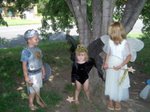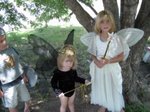It's amazing how many princesses there are in a country that doesn't recognize royalty of it's own. But every little girl is a princess, especially on her birthday, just ask her. Which is why on Sunday afternoon I picked up my son's youngest daughter and drove 32 miles to my brother's granddaughter's birthday party at
My Gym in Wichita KS. They began with some organized activities to get them warmed up.

I didn't take my camcorder but I did get some low quality video clips with my digital camera.
They hung padded blocks from the ceiling, swung them and had the girls attempt to run through them without getting hit.
 Then they were instructed to try to crawl under them, again without getting bonked on the head.
Then they were instructed to try to crawl under them, again without getting bonked on the head.
 Here they are all lined up and ready for another challenge.
Here they are all lined up and ready for another challenge.
 The birthday girl liked the giant ball that you could get in and roll around with.
The birthday girl liked the giant ball that you could get in and roll around with.
 Then there was climbing to be done.
Then there was climbing to be done.
 The video below is a short clip of story time. They set a couple exercise pads on edge making a walled in area. The leader then gathered all the children inside and told a story using some hand puppets. The children really enjoyed with and interacted quite loudly with the storyteller.
The video below is a short clip of story time. They set a couple exercise pads on edge making a walled in area. The leader then gathered all the children inside and told a story using some hand puppets. The children really enjoyed with and interacted quite loudly with the storyteller.
After the story they then played hide-n-seek. The leader stayed in the walled in area telling the children to go hide but not to hide in the ball pit because that is the first place she checks. She then counts to 20 as the other helpers lead the children to hide under the play equipment to the left of the gym. The leader comes out to look and goes directly to the ball pit which is to the front right of the gym. The helper then "sneaks" the children back to the "safe place" for the leader to discover them. Of course they were all giggling and not really fooling anyone. They did this a couple of times before going on to.... Picture time.

They then had cake and ice cream...

Presents from friends and family at the party were then opened...

...and a final short play time...

...before time to go home.

The final farewell in the ball pit.
Back at home, presents were opened that they hadn't wanted to haul to the gym only to haul home again. We had saved our present for opening at their home. See the Sponge Bob bag, that's the one that my granddaughter picked to use (but I didn't have any princess ones or I'm sure that's what she would have picked instead).

More toys than she will know what to do with, I'm sure.

A fabulous time was had by all and it was a wonderful way for 5 years
olds to celebrate a birthday. To jump and scream and holler and run and climb and not have any adults telling them to settle down.
 I couldn't decide which one to post. Which one do you think is the better angle?
I couldn't decide which one to post. Which one do you think is the better angle?
 A little history about my egg poacher. Growing up my mother had a 6 or 8 egg poacher that had removable cups for each egg making it real easy to take out the eggs one at a time. As an adult all I had in my kitchen was a single egg poacher which just wasn't convenient for two people for breakfast. I decided I'd just go buy me a multiple egg poacher. My sil and I went to stores all over Wichita KS and all we could come up with in multiple egg poachers didn't have the removable cups. At home, online, I was able to find some large ones like I wanted but they were in restaurant supply and rather pricey. I was resigned to give up my search for the time being and wrote of my wasted day to an online friend in England. This wonderful lady in England I had "met" when I had responded to a question she had posted on some board concerning publishing a book of her father's letters. She and I were soon corresponding regularly and exchanging pictures of children and grandchildren. Not long after my egg poacher lament she wrote me to expect a package in the mail from her not saying what it was that she was sending. A week or so later the package arrived and much to my pleasure and surprise was the egg poacher that you see in the picture here. I have not heard from my dear friend across the pond in sometime now, but I think of her fondly whenever I have poached eggs.
A little history about my egg poacher. Growing up my mother had a 6 or 8 egg poacher that had removable cups for each egg making it real easy to take out the eggs one at a time. As an adult all I had in my kitchen was a single egg poacher which just wasn't convenient for two people for breakfast. I decided I'd just go buy me a multiple egg poacher. My sil and I went to stores all over Wichita KS and all we could come up with in multiple egg poachers didn't have the removable cups. At home, online, I was able to find some large ones like I wanted but they were in restaurant supply and rather pricey. I was resigned to give up my search for the time being and wrote of my wasted day to an online friend in England. This wonderful lady in England I had "met" when I had responded to a question she had posted on some board concerning publishing a book of her father's letters. She and I were soon corresponding regularly and exchanging pictures of children and grandchildren. Not long after my egg poacher lament she wrote me to expect a package in the mail from her not saying what it was that she was sending. A week or so later the package arrived and much to my pleasure and surprise was the egg poacher that you see in the picture here. I have not heard from my dear friend across the pond in sometime now, but I think of her fondly whenever I have poached eggs.






































 I didn't take my camcorder but I did get some low quality video clips with my digital camera.
I didn't take my camcorder but I did get some low quality video clips with my digital camera.






















